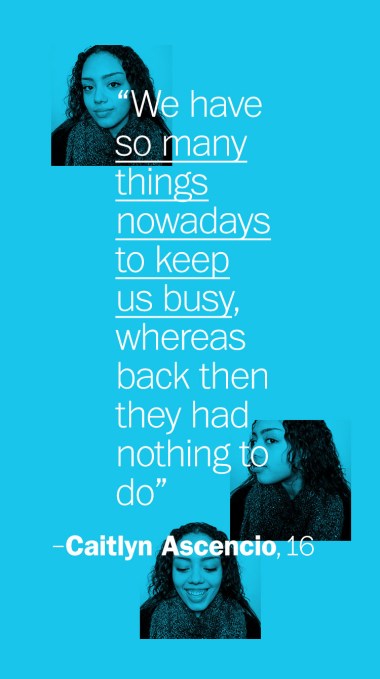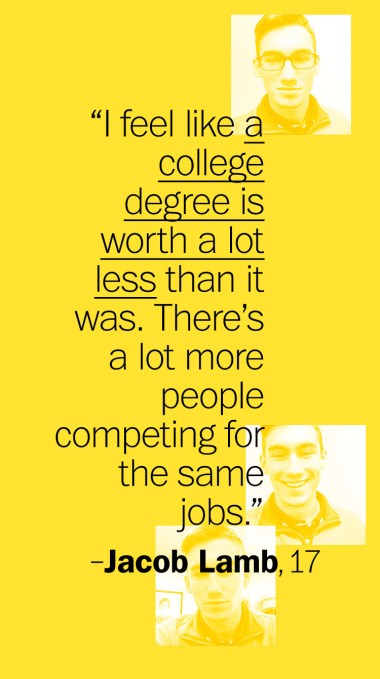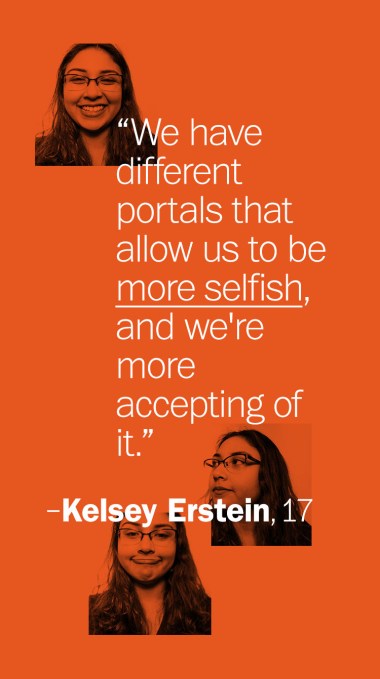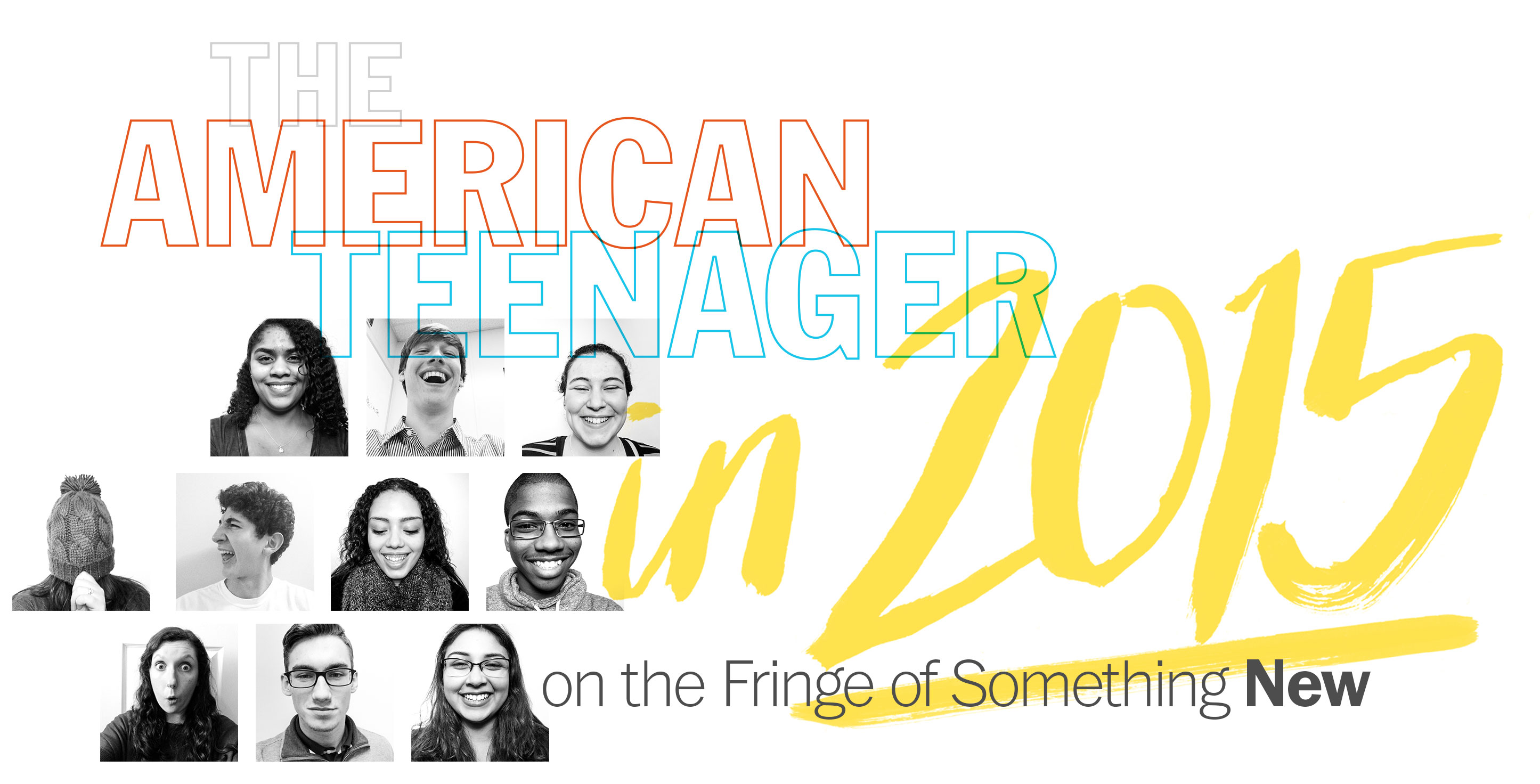
Story by Victor Luckerson
At Briarwood Christian High School, the boys’ bathrooms smell like blueberries. Many of the Birmingham, Ala., school’s students have taken up electronic cigarettes, which come in a variety of fruity flavors, and they decamp to the restroom to get their necessary nicotine hit between classes. Emphasis on the electronic here–Molly Lattner, a 17-year-old senior at Briarwood, says she’s never seen a person her age smoking a regular tobacco cigarette.
It’s a classic form of youthful rebellion with a modern twist, and in many ways it encapsulates how the teens today are not so different from the ones profiled by TIME in a 1965 cover story on the state of American teenagers. They’re still looking for ways to assert their individual identities, but it might happen on Snapchat instead of in the class yearbook. They’re still anxious about college, but they may be applying to five schools instead of one.
This new generation has been shaped by the events of the no-longer-new millennium. The youngest teenagers were not alive on September 11, 2001. They don’t remember when Barack Obama declared a post-racial America four years before becoming the first black President. They didn’t know what was going on during the 2008 financial crisis, though even today they’re aware that finding a job is tougher than it used to be. And, despite being dismissed as self-absorbed by some (including within their own ranks), they’re more aware of the social and political issues afflicting our nation than some adults give them credit for.

The digital lifestyle.
It’s harder to be a teen now than it was in 1965—at least according to teenagers. That’s not in spite of the Internet and the iPhone. It’s because of all the technology that surrounds us.
“We have more responsibilities because of all the technology that we have,” says Sharon Bayantemur, a 17-year-old student at East Side Community High School in New York City. “People expect more from you because they know you have a cell phone and they can contact you and you have to pick up. Back then you didn’t really have that obligation.”
There’s also the anxiety of having the most experimental years of their lives documented online for all to see. They know that mistakes can live forever on the Internet. That mentality helps explain why they’re leading the adoption of a new wave of anonymous and private communications platforms, such as Snapchat, YikYak and GroupMe. None of them makes phone calls anymore, unless it’s an urgent matter. “I don’t even know how to check my voicemail,” says Lukas Castellanos, an 18-year-old at Briarwood who performs theater.
But the digital lifestyle can take its toll when it comes time for real-life interactions. “We have different portals that allow us to be more selfish,” says Kelsey Erstein, a 17-year-old at East Side who’s into rock climbing, “and we’re more accepting of it.”
Very independent.
Teens say finding romance during high school is still important, but they’re not expecting to find lifelong love. The median age for marriage jumped from 22 to 28 between 1965 and 2013, according to the U.S. Census Bureau. “Back in the day you were very worried about finding a husband so they could take care of you,” says Emma Baker, an 18-year-old cheerleader at Briarwood. “Nowadays women can go to college and make a living on their own and be very independent. The pressure is a whole lot less.”
Same-sex relationships are greeted with indifference in some circles, too. Even the oldest teens were in elementary school when Massachusetts became the first state to legalize same-sex marriage in 2004. Though gay teenagers can still face discrimination, David Sides, a 17-year-old at Briarwood, says the antagonism is lessening. “Like, nobody cares. That’s your thing. I’m not gonna tell you you can’t do it, but I’m not going to give you a high five for it.”
At the same time, sexual activity among teens has been on a steady decline in recent decades. Though data from 1965 aren’t available, figures from the Centers for Disease Control show that the percentage of sexually active high schoolers dropped from 54% to 47% between 1991 and 2011. The number of partners per sexually active student is down too. Young folks have some theories for explaining the drop. “We have so many things nowadays to keep us busy, whereas back then they had nothing to do,” Caitlyn Ascencio, a 16-year-old student at East Side, says laughing. (These facts, however, haven’t done much to assuage the long-held notion in high school that everyone else is having sex.)

Judged for your skin color.
Though today’s youngest teens barely remember a time before the U.S. had a black president, ongoing racial tensions are still evident to many of them. “You’re constantly being judged for, like, absurd things–your skin color, how you dress,” 13-year old Dayahna Camacho says of life in Montbello, a mostly black and Hispanic neighborhood in Denver. She attends a charter school called STRIVE Preparatory in the city.
Though the segregation described in 1965 is supposed to be a thing of the past, some teens say their perception of racial progress changed following the lack of indictments for police officers involved in the killings of two black men, Michael Brown and Eric Garner, in 2014. “Before I was kind of aloof to it,” says Lonnie Hancock, a 16-year-old at East Side. “Now I feel like it kind of is more in your face that things aren’t exactly O.K.” At his school, students left their classrooms in Manhattan one day in December to march in protest of the justice system’s handling of the Garner case. It didn’t go unnoticed that the event sounded like something they might have learned in history class.
There’s a sense among many, especially at schools largely populated by minorities, that racial issues will persist in the future. “There’s always going to be a race problem all around the world,” says Ibrahim Diallo, the 18-year-old captain of East Side’s basketball team. “You’re just going to have to find a way to deal with it.”
But teens are also searching for nuance in what’s become a heated social debate. “My uncle is a captain in the police force and I respect him as a person,” says Luz Robles, a 17-year-old at East Side who serves as student council president and marched in the protest. “I don’t think it’s police in general. I think it’s just certain people who are spoiling it for all of them.”
Overall, teens seem to understand that racial progress has to be earned by each successive generation. In Alabama, Sides says racist sentiment is still too common among older people. “I think it’s our job now to completely erase that sentiment,” he says, “but you still see the tendrils creeping down into society.”
No hushed tones.
Teens are still experimenting with new substances, but their preferences have changed. Alcohol use by teens has declined since the 1970s; about 70% of 12th graders in 1975 said they’d drunk alcohol within the last 30 days, but that percentage dropped below 40% in 2014, according to the annual Monitoring the Future study conducted by the University of Michigan.
Marijuana use among that group plummeted in the ’80s, when Nancy Reagan was teaching students to “Just Say No” to drugs, but today usage is right about where it was in 1975. Forty percent of 12th graders say they’ve smoked weed in the past year. With marijuana legalized in a growing number of states, the drug is no longer viewed as particularly dangerous or rebellious. “You would speak about it in a hushed tone maybe, like, ten years ago,” says Hancock. “Now you could be screaming across the room to a friend, ‘Hey! Want to go smoke?”
Instead, electronic cigarettes are the newest teen obsession. CDC research shows that in 2013, 4.5% of high students reported using e-cigarettes. At schools like Briarwood, the figure is much higher—and it’s helped by e-cigs’ lack of pungent tobacco odor. Though some teens say their parents are their best friends, they still don’t want their folks to know everything they’re up to.

An uncertain future.
“In a way we are all kind of dreading the future,” admits Kristen Beckles, a 17-year-old at East Side who is part of a student leadership group. “We don’t know what comes after.”
Today’s teens are coming of age in the shadow of the largest financial calamity since the Great Depression. College tuition, room and board has increased more than tenfold since 1965, according to the Department of Education. And, after remaining relatively stable in the 1960’s, the income gap between the wealthiest 1% of Americans and everyone else has been growing for three decades is now is the largest it’s been since 1928, according to a University of California-Berkley researcher.
For many teens, these realities mean choosing a college is more about pragmatism than pursuing a dream. There’s also an anxiety about the world that will be waiting after college. “It’s going to be a lot more difficult,” says Jacob Lamb, a 17-year-old senior at Briarwood who plays football. “I feel like a college degree is worth a lot less than it was. There’s a lot more people competing for the same jobs.”
But the changes of recent decades have also created new opportunities. Beth Rodriguez-Cortes, a 13-year-old at STRIVE Prep in Denver, believes she’ll have an easier time reaching college than her parents. “They were undocumented when they came here, so they didn’t really get the chance to go to college,” she says. “I think I’ll have an easier time getting an education.”
None of these kids know what will come ahead—but, as 50 years of history have shown, that’s part of being a teenager. They’ll enter adulthood under a new President and assume jobs that don’t yet exist. They’ll carry gadgets we haven’t even dreamed up and deal with social problems that haven’t yet broken into the mainstream. They’re going to figure out the future because they have no other choice.
“I feel like if we knew what was going to happen, like, every five seconds of the day, it’d be really boring,” says Hancock, of East Side. “I actually kind of like the mystery. It’s a scary excitement.”
time.com/wp-content/uploads/2015/01/1965teens.jpg?w=770#mobile
